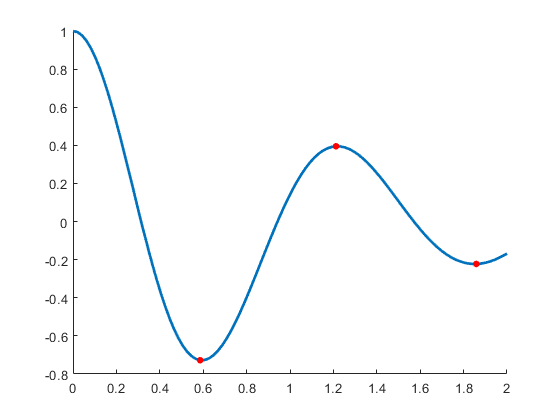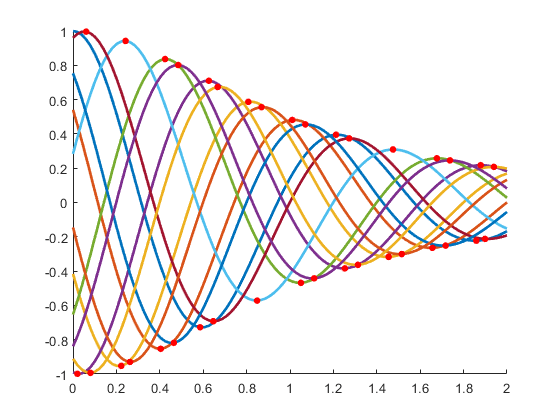用于显示不定数量的线条的优化图类
此示例说明如何优化一个图类以显示不定数量的线条。它重用现有线条对象,这可以提高图的性能,尤其是在线条的数量不经常变化的情况下。有关未经优化的此图的更简单版本,请参阅具有可变数量的线条的图类。
图显示的线条数与 YData 矩阵中的列数一样多,在局部极值处有圆形标记。以下代码说明如何:
定义两个属性,名称分别为
PlotLineArray和ExtremaLine,分别用于存储线条和标记的对象。实现用于初始化
ExtremaLine对象的setup方法。实现用于获取
PlotLineArray的大小的update方法,然后根据YData中的列数在该数组中加减对象。
要定义该类,请将以下代码复制到编辑器中,并将其以名称 OptimLocalExtremaChart.m 保存在可写文件夹中。
classdef OptimLocalExtremaChart < matlab.graphics.chartcontainer.ChartContainer % c = OptimLocalExtremaChart('XData',X,'YData',Y,Name,Value,...) % plots one line with markers at local extrema for every column of matrix Y. % You can also specify the additonal name-value arguments, 'MarkerColor' % and 'MarkerSize'. properties XData (:,1) double = NaN YData (:,:) double = NaN MarkerColor {validatecolor} = [1 0 0] MarkerSize (1,1) double = 5 end properties(Access = private,Transient,NonCopyable) PlotLineArray (:,1) matlab.graphics.chart.primitive.Line ExtremaLine (:,1) matlab.graphics.chart.primitive.Line end methods(Access = protected) function setup(obj) obj.ExtremaLine = matlab.graphics.chart.primitive.Line(... 'Parent', obj.getAxes(), 'Marker', 'o', ... 'MarkerEdgeColor', 'none', 'LineStyle',' none'); end function update(obj) % Get the axes ax = getAxes(obj); % Create extra lines as needed p = obj.PlotLineArray; nPlotLinesNeeded = size(obj.YData, 2); nPlotLinesHave = numel(p); for n = nPlotLinesHave+1:nPlotLinesNeeded p(n) = matlab.graphics.chart.primitive.Line('Parent', ax, ... 'SeriesIndex', n, 'LineWidth', 2); end % Update the lines for n = 1:nPlotLinesNeeded p(n).XData = obj.XData; p(n).YData = obj.YData(:,n); end % Delete unneeded lines delete(p((nPlotLinesNeeded+1):numel(p))) obj.PlotLineArray = p(1:nPlotLinesNeeded); % Replicate x-coordinate vectors to match size of YData newx = repmat(obj.XData(:),1,size(obj.YData,2)); % Find local minima and maxima and plot markers tfmin = islocalmin(obj.YData,1); tfmax = islocalmax(obj.YData,1); obj.ExtremaLine.XData = [newx(tfmin); newx(tfmax)]; obj.ExtremaLine.YData = [obj.YData(tfmin); obj.YData(tfmax)]; obj.ExtremaLine.MarkerFaceColor = obj.MarkerColor; obj.ExtremaLine.MarkerSize = obj.MarkerSize; % Make sure the extrema are on top uistack(obj.ExtremaLine, 'top'); end end end
保存类文件后,可以创建图的实例。例如:
x = linspace(0,2)'; y = cos(5*x)./(1+x.^2); c = OptimLocalExtremaChart('XData',x,'YData',y);

现在,创建一个 for 循环,该循环在每次迭代时向图中添加一个线条。图对象会保留所有现有线条,并为每个 i 另外添加一个线条。
for i=1:10 y = cos(5*x+i)./(1+x.^2); c.YData = [c.YData y]; end
